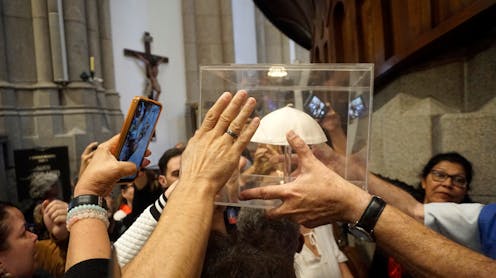Detta inlägg post publicerades ursprungligen på denna sida this site ;
Date:
Author: Tony Milligan, Research Fellow in the Philosophy of Ethics, King's College London
Original article: https://theconversation.com/pope-franciss-death-reveals-a-hidden-truth-about-public-grief-255157

When a significant international public figure like Pope Francis dies, the world seems to pause. Tributes pour in, flags lower, candles flicker in city squares. The sadness is palpable. But is this real grief, or something else entirely?
Widespread mourning can look and feel genuine. And in many ways, it is. Most people aren’t faking their sorrow. But public grief often lacks depth and duration – it fades almost as quickly as it appears.
For those who knew Francis personally, the loss will be profound and lasting. For the rest of us, we are witnesses to the passing of a beloved figure, not mourners in the intimate sense.
The world saw this after the deaths of Princess Diana and Pope John Paul II. Both were enormously popular and the global reaction was immense. Yet, weeks after their funerals, the emotional tide began to recede.
This time, the public response to Pope Francis feels more restrained. Less swept away by the moment. Less inclined toward what some psychologists refer to as false emotion – emotions that appear sincere but don’t reflect deep personal experience.
Partly, this is due to Pope Francis himself. He was not one for drama. Partly, it’s a quiet recognition: feeling sad about his death is not the same as being grief-stricken.
Still, the absence of a one-to-one relationship doesn’t necessarily make our feelings inauthentic. Millions may grieve for Francis without having met him. For devout Catholics and others inspired by his leadership, he was a symbol of hope, a voice for justice, humility and reform within an often troubled institution.
His life carried a transformative power, and for those who pinned their hopes on him – on what he represented – his passing may leave a genuine and lasting void. That looks a lot like real grief.
Longing and hope
Every Catholic I’ve ever known has had a “favourite pope.” The new one rarely feels the same. That attachment, though deeply symbolic, is emotionally real.
My father used to tell a story – likely embellished – about growing up in a Catholic neighbourhood in Bridgeton in the east end of Glasgow. When a neighbour’s home caught fire, she pleaded with firemen: “Save him! Save my darlin’!” They rushed in, expecting a person. All they found was a picture of the pope.
Even if exaggerated, the point holds: people feel a real longing for these figures. And that’s what grief is, in essence – a yearning for the impossible return of someone we’ve lost. It’s not just sadness. It’s the ache of a love that can no longer be reciprocated.
Priests who experience crises of faith describe something similar – a desire to return to a state of belief that now feels unreachable. It’s not just about loss; it’s about longing without resolution.
But when the new pope is announced, the atmosphere in St Peter’s Square is not one of despair. It’s a return to hope, not an immersion in grief. People may mourn Francis, but they’re also swept up in collective emotion – a desire to be part of history, part of the moment. That sense of unity can be powerful and real, even if it isn’t grief.
Atheists can feel it as much as believers. We sense it at funerals of people we didn’t really know. We cry because everyone else is crying. Then, days later, we carry on as if nothing happened.
Impossible desire
So, what makes false grief false? It’s not deception or performance – it’s the absence of impossible desire. In true grief, we yearn for what can never return. Most of us, when mourning a figure like Pope Francis, may want something – meaning, comfort, community. This is at the heart of what makes a false emotion false, rather than the real thing.
A false emotion lacks the desire that sits at the heart of its genuine counterpart. In the case of false grief, we may desire something. We usually do. The crowds who gather in St Peter’s Square and those of us who watch events unfold on TV clearly want something. But in most cases we do not have the right kind of impossible desire for our feelings to count as grief. Even if we do think of ourselves as grief stricken, we are mistaken.
Saying this is not at odds with Francis’s own religious tradition. In his biographical Confessions, St Augustine notoriously claimed that we always want unity with God, and we are restless until we achieve it: “Our heart is restless until it rests in you.”
But Augustine also claimed that this longing comes disguised as a desire for all sorts of other things: fame, alcohol, intoxication and the warm pleasures of the flesh. Augustine was a little on the puritanical side about these matters, but his idea of disguised longing may be close to the truth.
The point is that an emotion which presents misleadingly as one thing, may be a real instance of something else. In the case of Pope Francis, this may be this may be closer to spiritual longing rather than actual grief.
And whether or not we believe in a god, and however we want to describe it, longing of this sort is a deep and familiar experience. One that shifts our attention from object to object, or from one public figure to the next, without ever being satisfied.
In a sense, this is also the point of having a pope, or rather a succession of popes. It is easier to attach our longings onto someone human than it is to come to grips with deeper and often unmanageable desires.
![]()
Tony Milligan does not work for, consult, own shares in or receive funding from any company or organisation that would benefit from this article, and has disclosed no relevant affiliations beyond their academic appointment.

